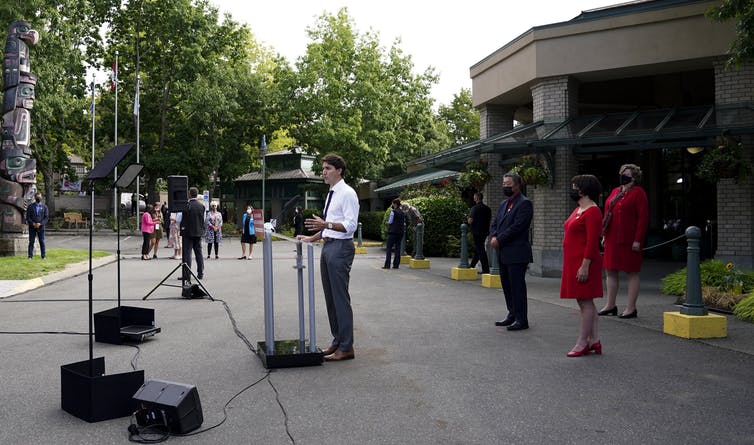
As a long-time researcher of the health and social impacts of dementia, I keep a constant, close eye on what governments do to support 500,000 Canadians living in residential care facilities and 7.8 million family caregivers. Or should I say, what governments don’t do.
So far during this election campaign, I have seen little to inspire hope that any party leader recognizes the pressing needs of seniors in care, 87 per cent of whom are cognitively impaired, or of the families who devote time and energy to them.
Let’s not forget that in the first wave of COVID-19, long-term care (LTC) residents accounted for 81 per cent of all COVID-19 deaths in Canada (the highest proportion of LTC COVID-19 deaths in the world) and tens of thousands were left to suffer in isolation, for months on end. How can the federal election agenda not include a policy ensuring families access to LTC residents as essential visitors?
Table of Contents
Families as essential caregivers
Along with loneliness, sickness and death, COVID-19 brought attention to the crucial role that family members play in supporting people in long-term care. Most caregivers are women, who bear the brunt of government inattention to the cost to their mental and physical health as they provide “free” care to their elderly loved ones, who are also mostly women. Why isn’t easing their burden, and that of their mothers and grandmothers who require care, a major platform item for our famously feminist prime minister?
A commonly cited national benchmark for quality long-term care is just over four hours a day of direct care per resident. Provincial averages vary, with New Brunswick the lowest at a mere 3.1 hours. British Columbia uses a target of 3.36 hours per day, and Manitoba averages 3.6. Family caregivers pick up the slack.

THE CANADIAN PRESS/Darryl Dyck
Family caregivers may visit daily for several hours to make essential contributions that include assistance in walking or mobility, psychosocial support (such as taking the senior outside to prevent social isolation) and personal care, which can include bathing, grooming, assisting with meals and dressing.
Read more:
Long-term care after the COVID-19 disaster: 3 promising ways to move forward
Families also assist with housekeeping, getting loved ones to appointments and doing personal laundry. In fact, these essential care partners contribute up to $66.5 billion annually in unpaid care to patients in hospital, long-term care, group care settings and home care.
In Ontario, one-third of LTC residents do not even have the comparative luxury of family help: they depend on staff for their basic needs. As we heard through media during the pandemic, residents who don’t have family present — and that was all of them for months — don’t get the best care from overburdened staff, who have annual turnover rates as high as 400 per cent.
Party platforms disappoint on LTC

THE CANADIAN PRESS/Sean Kilpatrick
The major parties’ platforms on long-term care issues makes frustrating reading. The Liberal party promises $25-an-hour wages and to ensure 50,000 more workers are hired and trained. This vow at least gets at low wages (now averaging $17 an hour), and the need to attract more workers. The Conservatives say they will promote careers through immigration, which is not new. The NDP says it will improve working conditions for staff but offers no specifics.
The Liberals and Conservatives both promise $3 billion to fix up LTC homes, and both parties say they will use tax credits to encourage seniors to remain in their own homes. The NDP says it will end for-profit long-term care, which would, in fact, increase quality and safety of care for residents.
Read more:
We must eliminate profit-making from child care and elder care
A recent analysis by the Canadian Institute for Health Information indicates that one in nine people who moved into long-term care in 2018-19 could potentially have been cared for at home. That might be a better option, but where would the support be? The Conservatives say they would pay $200 a month to families to care for elders in their homes. That amount cannot begin to make a meaningful difference when caregivers’ lives and savings are taken over by the daily demands of helping their loved ones.
National standards
The Canadian Health Coalition argues that what is needed is a National Seniors Care Strategy to establish “consistent standards of funding, care, and staffing levels across federal, provincial and territorial jurisdictions.”

THE CANADIAN PRESS/Frank Gunn
LTC homes in Canada are funded and administered through a mix of private for-profit, private non-profit and publicly owned facilities. The quality of care at publicly owned care homes is better (as measured by higher staffing levels and fewer transfers to emergency departments) and yet they account for only 46 per cent of LTC facilities in Canada. One in three facilities is for-profit; taking that profit out would increase quality.
We spend billions on care homes (ironically named since many do not seem care-centred), public and private, where nobody wants to end up. Canadians who have spent their lives contributing to this country, with their work, taxes and community activities, deserve more at the end of their lives than to be considered a drain on the public purse.
We need high national standards for long-term care within the Canada Health Act, which currently only covers hospital and doctor services. National standards are needed to ensure the right for seniors in LTC homes to have essential visitors always, even in pandemics.
When no other real support is available, tax credits, token payments and aspirational words don’t cut it. We need equitable access and quality in long-term care across the country. We need the political will and leadership to make it happen and place seniors, caregivers and workers at the moral and operational centre of long-term care. That would get my vote.
![]()
Debra Sheets does not work for, consult, own shares in or receive funding from any company or organisation that would benefit from this article, and has disclosed no relevant affiliations beyond their academic appointment.
























